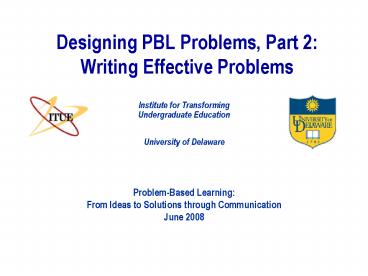Designing PBL Problems, Part 2: Writing Effective Problems - PowerPoint PPT Presentation
1 / 18
Title:
Designing PBL Problems, Part 2: Writing Effective Problems
Description:
... 15th century used to believe it was possible to fall off the earth. ... A mother breaks into a drugstore to obtain expensive, life-saving drugs for her child. ... – PowerPoint PPT presentation
Number of Views:96
Avg rating:3.0/5.0
Title: Designing PBL Problems, Part 2: Writing Effective Problems
1
Designing PBL Problems, Part 2Writing Effective
Problems
Institute for TransformingUndergraduate Education
University of Delaware
Problem-Based Learning From Ideas to Solutions
through Communication June 2008
2
Getting Started Course Specifics
3
Getting Ideas for Writing Problems
- Begin with the desired learning objectives.
- Look for a real-life example or situation that
involves those concepts.
- Begin with a real-life story or example.
- What content and process objectives might be
found in that story?
4
Problem Sources and Strategies
- News events, articles
- Popular or scholarly press in the discipline
- Authentic tasks, roles, etc. as triggers
- Case studies
- Adaptation of text problems or questions
5
Source Example News Event
- Trigger NY Times report of Galapagos oil spill
- Problem Conversation between 2 oil molecules
6
Source Example News Event
- Task
- Be compassionate and try to see this
situation from an oil molecules point of view.
Describe yourself what is your (molecular level)
environment like, both before and after the oil
spill? Why do you behave as you do? What will
the cleanup guys bring to this picture? - Concepts introduced
- energetics of solution formation, solubility and
intermolecular forces, micelles, surfactants,
chemical rationale behind cleanup, environmental
issues
7
Source Example Authentic Tasks
- Trigger discussion of National Film Preservation
Act - Problem choose a film to nominate for inclusion
in the National Film Registry - Task prepare a critical analysis of the film and
submit a persuasive nomination to the Library of
Congress. - Concepts introduced theories and strategies of
film analysis, development of evaluative criteria - PBL Clearinghouse Problem submitted by Bryan
Johnson, Samford University, 2001
8
Source ExampleTextbook Problems
- Physics concept conservation of momentum
- Text examples colliding pool balls, car
collisions
A 1200-kg car traveling east with a speed of 10
m/s collides at an intersection with a 1500-kg
van traveling north at a speed of 12 m/s. Find
the direction and magnitude of the velocity of
the wreckage after the collision, assuming that
the vehicles undergo a perfectly inelastic
collision (ie, they stick together).
9
Source Example Textbook Problems
- Problem students, in role of police officer,
must determine culpability in fatal car crash
based on data (disclosed progressively) from
actual police accident report. Assumptions/approxi
mations required different choices lead to
different conclusions.
PBL Clearinghouse Problem Submitted by Barbara
Duch, 2001
10
Problem Writing Exercise
- Identify 1-2 major learning objectives that you
want to address through a problem - consider both
content concepts and process skills. - Identify a real-world context or application of
those concepts. (Steps 1 and 2 may be reversed.) - Develop a scenario or story to set the stage.
- Begin drafting the problem by outlining the first
page. - Provide a brief synopsis of what the rest of the
problem will look like other stages, products,
etc.
There will be time Friday morning for some to
present their problem ideas and receive feedback
from the group.
11
Problem Writing Step One
- 1. Identify 1-2 major learning objectives
that you want to address through a problem. - - Consider both content concepts and process
skills. - OR
- 1. Identify a real-world context or application
of ideas related to your course.
12
Problem Writing Step Two
- 2. Identify a real-world context or
application of those concepts. - - Why does a student need to learn this
material? - - How and where does it appear outside the
classroom? - OR
- 2. Identify the learning objectives embedded in
the example you have chosen.
13
Problem Writing Step Three
- 3. Develop a scenario or story to set the stage.
- - Current events or topical issues help capture
interest. - - Consider a story-telling voice rather than
straight presentation of information. - - Characters, dialogue, humor can help get
students attention. - - Keep student perspective in mind why should I
care about this? Consider situations related to
student life, interests, future career plans or
roles, etc.
14
Problem Writing Step Four
- 4. Begin drafting the problem by outlining the
first page. - - Multi-page/stage problems often move from
general questions (whats going on here?) to
more specific tasks. - Open-ended initial questions promote group
discussion - Progressive elaboration of problem and/or
disclosure of information helps to keep up
interest. - - Resist the urge to provide too much
information. - - Problems need not be real, but avoid overly
contrived situations.
15
Problem Writing Step Five
- 5. Provide a brief synopsis of what the rest
of the problem will look like other stages,
products, etc. - - Ambiguities provide opportunities for students
to make assumptions and to see their
consequences. - - Elements of controversy and judgment help
develop higher order thinking and communication
skills. - - There need not be one right answer.
16
Another Scheme for Categorizing Problems -
Based on Types of Knowledge
Source M. Savin-Baden and C. Major. 2004.
Foundations of PBL. Berkshire, England Open
University Press.
17
Types of Problems Based on Type of Knowledge
18
Problem Writing Cycle
- Start with a Story Start with
the Concepts - Research
Research - What concepts are involved?
Look for the story to use - Research the Problem
- First Draft
- (Consider point of view, focus, appropriateness
for audience, staging, objectives, nature of the
end-of-stage questions) - Research, Draft II (refine)
- Teaching
- Draft III
From C. F. Herreid, SUNY Buffalo W. Welty, Pace
University































